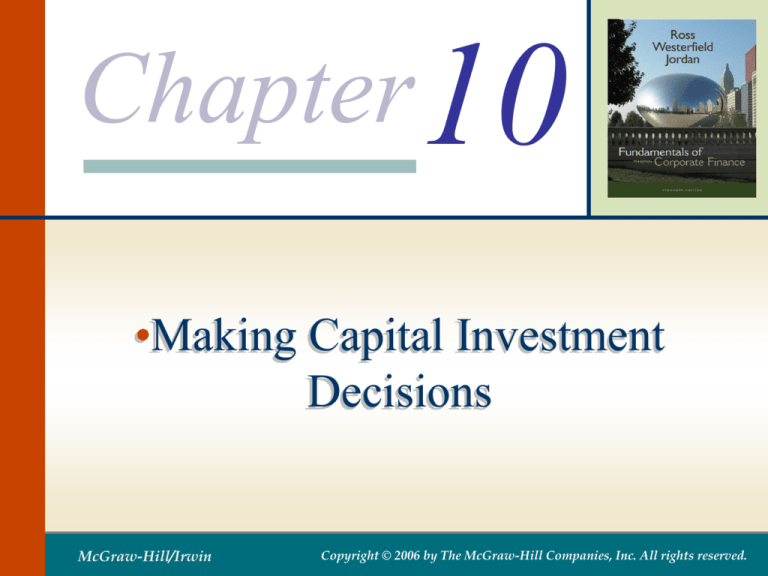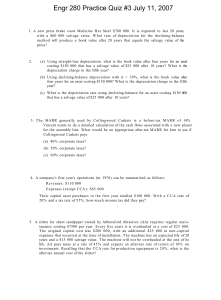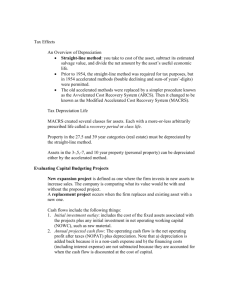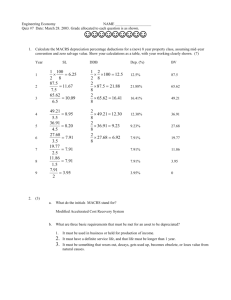
Chapter 10
•Making Capital Investment
Decisions
McGraw-Hill/Irwin
Copyright © 2006 by The McGraw-Hill Companies, Inc. All rights reserved.
Key Concepts and Skills
• Understand how to determine the relevant
cash flows for various types of proposed
investments
• Be able to compute depreciation expense
for tax purposes
• Understand the various methods for
computing operating cash flow
10-1
Chapter Outline
• Project Cash Flows: A First Look
• Incremental Cash Flows
• Pro Forma Financial Statements and
Project Cash Flows
• More on Project Cash Flow
• Alternative Definitions of Operating Cash
Flow
• Some Special Cases of Cash Flow
Analysis
10-2
Relevant Cash Flows
• The cash flows that should be included in a
capital budgeting analysis are those that
will only occur if the project is accepted
• These cash flows are called incremental
cash flows
• The stand-alone principle allows us to
analyze each project in isolation from the
firm simply by focusing on incremental
cash flows
10-3
Asking the Right Question
• You should always ask yourself “Will this
cash flow occur ONLY if we accept the
project?”
• If the answer is “yes”, it should be included in
the analysis because it is incremental
• If the answer is “no”, it should not be included
in the analysis because it will occur anyway
• If the answer is “part of it”, then we should
include the part that occurs because of the
project
10-4
Common Types of Cash Flows
• Sunk costs – costs that have accrued in the past
• Opportunity costs – costs of lost options
• Side effects
• Positive side effects – benefits to other
projects
• Negative side effects – costs to other projects
• Changes in net working capital
• Financing costs
• Taxes
10-5
Pro Forma Statements and Cash
Flow
• Capital budgeting relies heavily on pro
forma accounting statements, particularly
income statements
• Computing cash flows – refresher
• Operating Cash Flow (OCF) = EBIT +
depreciation – taxes
• OCF = Net income + depreciation when there
is no interest expense
• Cash Flow From Assets (CFFA) = OCF – net
capital spending (NCS) – changes in NWC
10-6
Table 10.1 Pro Forma Income
Statement
Sales (50,000 units at $4.00/unit)
$200,000
Variable Costs ($2.50/unit)
125,000
Gross profit
$ 75,000
Fixed costs
12,000
Depreciation ($90,000 / 3)
30,000
EBIT
Taxes (34%)
Net Income
$ 33,000
11,220
$ 21,780
10-7
Table 10.2 Projected Capital
Requirements
Year
0
NWC
$20,000
NFA
90,000
Total
$110,000
1
2
$20,000 $20,000
60,000
3
$20,000
30,000
0
$80,000 $50,000
$20,000
10-8
Table 10.5 Projected Total Cash
Flows
Year
0
OCF
Change
in NWC
-$20,000
NCS
-$90,000
CFFA
-$110,00
1
2
3
$51,780
$51,780
$51,780
20,000
$51,780
$51,780
$71,780
10-9
Making The Decision
• Now that we have the cash flows, we can
apply the techniques that we learned in
chapter 9
• Enter the cash flows into the calculator and
compute NPV and IRR
• CF0 = -110,000; C01 = 51,780; F01 = 2; C02 =
71,780
• NPV; I = 20; CPT NPV = 10,648
• CPT IRR = 25.8%
• Should we accept or reject the project?
10-10
More on NWC
• Why do we have to consider changes in
NWC separately?
• GAAP requires that sales be recorded on the
income statement when made, not when cash
is received
• GAAP also requires that we record cost of
goods sold when the corresponding sales are
made, whether we have actually paid our
suppliers yet
• Finally, we have to buy inventory to support
sales although we haven’t collected cash yet
10-11
Depreciation
• The depreciation expense used for capital
budgeting should be the depreciation
schedule required by the IRS for tax
purposes
• Depreciation itself is a non-cash expense;
consequently, it is only relevant because it
affects taxes
• Depreciation tax shield = DT
• D = depreciation expense
• T = marginal tax rate
10-12
Computing Depreciation
• Straight-line depreciation
• D = (Initial cost – salvage) / number of years
• Very few assets are depreciated straight-line
for tax purposes
• MACRS
• Need to know which asset class is appropriate
for tax purposes
• Multiply percentage given in table by the initial
cost
• Depreciate to zero
• Mid-year convention
10-13
After-tax Salvage
• If the salvage value is different from the
book value of the asset, then there is a tax
effect
• Book value = initial cost – accumulated
depreciation
• After-tax salvage = salvage – T(salvage –
book value)
10-14
Example: Depreciation and Aftertax Salvage
• You purchase equipment for $100,000 and
it costs $10,000 to have it delivered and
installed. Based on past information, you
believe that you can sell the equipment for
$17,000 when you are done with it in 6
years. The company’s marginal tax rate is
40%. What is the depreciation expense
each year and the after-tax salvage in year
6 for each of the following situations?
10-15
Example: Straight-line
Depreciation
• Suppose the appropriate depreciation
schedule is straight-line
• D = (110,000 – 17,000) / 6 = 15,500 every
year for 6 years
• BV in year 6 = 110,000 – 6(15,500) = 17,000
• After-tax salvage = 17,000 - .4(17,000 –
17,000) = 17,000
10-16
Example: Three-year MACRS
Year
MACRS
percent
D
1
.3333
.3333(110,000) =
36,663
2
.4444
.4444(110,000) =
48,884
3
.1482
.1482(110,000) =
16,302
4
.0741
.0741(110,000) =
8,151
BV in year 6 =
110,000 – 36,663 –
48,884 – 16,302 –
8,151 = 0
After-tax salvage
= 17,000 .4(17,000 – 0) =
$10,200
10-17
Example: 7-Year MACRS
Year
MACRS
Percent
D
1
.1429
.1429(110,000) = 15,719
2
.2449
.2449(110,000) = 26,939
3
.1749
.1749(110,000) = 19,239
4
.1249
.1249(110,000) = 13,739
5
.0893
.0893(110,000) = 9,823
6
.0893
.0893(110,000) = 9,823
BV in year 6 =
110,000 – 15,719 –
26,939 – 19,239 –
13,739 – 9,823 –
9,823 = 14,718
After-tax salvage
= 17,000 .4(17,000 –
14,718) =
16,087.20
10-18
投資計畫依關聯性來區分
• 獨立型
投資計畫不會影響到其他計畫的採行
與否。
• 互斥型
投資計畫的採行與其他計畫的採行是
有衝突的。
• 權變型
欲接受某投資計畫,必須在其他計畫
已被接受的前提下才可行。
10-19
投資計畫依其內容來區分
• 重置型
重置型投資計畫目的在於汰舊換新與
提升營運效率。
• 擴充型
擴充型投資計畫為填補不同的需求缺
口。
• 管制型
管制型投資計畫為了經營的合法性或
企業道德等無形因素。
10-20
進行評估之前的準備工作
• 原始淨投資額
• 原始淨投資額
=使用資產的直接成本
其他相關成本或投資抵減額
• 其他相關成本包含:增加的淨營運資金、舊
資產處分所得及購買與處分資產的所得稅效
果。
• 營運現金流量
• 因採行此投資計畫後,各期額外增加的現金
流量。
10-21
進行評估之前的準備工作(續)
• 期末現金流量
• 期末現金流量=當期營運現金流量+處分資產
所得±處分資產之所得稅效果+淨營運資金的回
收
10-22
Example: Replacement Problem
• Original Machine
• Initial cost = 100,000
• Annual depreciation =
9000
• Purchased 5 years ago
• Book Value = 55,000
• Salvage today =
65,000
• Salvage in 5 years =
10,000
• New Machine
•
•
•
•
Initial cost = 150,000
5-year life
Salvage in 5 years = 0
Cost savings = 50,000
per year
• 3-year MACRS
depreciation
• Required return =
10%
• Tax rate = 40%
10-23
Replacement Problem –
Computing Cash Flows
• Remember that we are interested in
incremental cash flows
• If we buy the new machine, then we will
sell the old machine
• What are the cash flow consequences of
selling the old machine today instead of in
5 years?
10-24
Replacement Problem – Pro
Forma Income Statements
Year
Cost
Savings
1
2
3
4
5
50,000
50,000
50,000
50,000
50,000
New
49,500
67,500
22,500
10,500
0
Old
9,000
9,000
9,000
9,000
9,000
40,500
58,500
13,500
1,500
(9,000)
EBIT
9,500
(8,500)
36,500
48,500
59,000
Taxes
3,800
(3,400)
14,600
19,400
23,600
NI
5,700
(5,100)
21,900
29,100
35,400
Depr.
Increm.
10-25
Replacement Problem – Incremental
Net Capital Spending
• Year 0
• Cost of new machine = 150,000 (outflow)
• After-tax salvage on old machine = 65,000 .4(65,000 – 55,000) = 61,000 (inflow)
• Incremental net capital spending = 150,000 –
61,000 = 89,000 (outflow)
• Year 5
• After-tax salvage on old machine = 10,000 .4(10,000 – 10,000) = 10,000 (outflow
because we no longer receive this)
10-26
Replacement Problem – Cash
Flow From Assets
Year
0
1
2
46,200 53,400
OCF
3
4
5
35,400
30,600
26,400
NCS
-89,000
-10,000
In
NWC
CFFA
0
0
-89,000
46,200 53,400
35,400
30,600
16,400
10-27
Replacement Problem –
Analyzing the Cash Flows
• Now that we have the cash flows, we can
compute the NPV and IRR
• Enter the cash flows
• Compute NPV = 54,812.10
• Compute IRR = 36.28%
• Should the company replace the
equipment?
10-28
Other Methods for Computing
OCF
• Bottom-Up Approach
• Works only when there is no interest expense
• OCF = NI + depreciation
• Top-Down Approach
• OCF = Sales – Costs – Taxes
• Don’t subtract non-cash deductions
• Tax Shield Approach
• OCF = (Sales – Costs)(1 – T) +
Depreciation*T
10-29
Example: Cost Cutting
• Your company is considering a new computer
system that will initially cost $1 million. It will
save $300,000 a year in inventory and
receivables management costs. The system is
expected to last for five years and will be
depreciated using 3-year MACRS. The system is
expected to have a salvage value of $50,000 at
the end of year 5. There is no impact on net
working capital. The marginal tax rate is 40%.
The required return is 8%.
• Click on the Excel icon to work through the
example
10-30
Example: Setting the Bid Price
• Consider the following information:
• Army has requested bid for multiple use digitizing
devices (MUDDs)
• Deliver 4 units each year for the next 3 years
• Labor and materials estimated to be $10,000 per unit
• Production space leased for $12,000 per year
• Require $50,000 in fixed assets with expected salvage
of $10,000 at the end of the project (depreciate
straight-line)
• Require initial $10,000 increase in NWC
• Tax rate = 34%
• Required return = 15%
10-31
Example: Equivalent Annual Cost
Analysis
• Burnout Batteries
• Initial Cost = $36 each
• 3-year life
• $100 per year to keep
charged
• Expected salvage = $5
• Straight-line depreciation
• Long-lasting Batteries
• Initial Cost = $60 each
• 5-year life
• $88 per year to keep
charged
• Expected salvage = $5
• Straight-line depreciation
The machine chosen will be replaced indefinitely and neither
machine will have a differential impact on revenue. No change
in NWC is required.
The required return is 15% and the tax rate is 34%.
10-32
不同期限計劃之評估---「共同生命週期
(Common Life)」與「等額年金 (EAA)」
10-33
10-34
Quick Quiz
• How do we determine if cash flows are
relevant to the capital budgeting decision?
• What are the different methods for
computing operating cash flow and when
are they important?
• What is the basic process for finding the
bid price?
• What is equivalent annual cost and when
should it be used?
10-35
Chapter 10
•End of Chapter
McGraw-Hill/Irwin
Copyright © 2006 by The McGraw-Hill Companies, Inc. All rights reserved.






![Quiz chpt 10 11 Fall 2009[1]](http://s3.studylib.net/store/data/005849483_1-1498b7684848d5ceeaf2be2a433c27bf-300x300.png)
